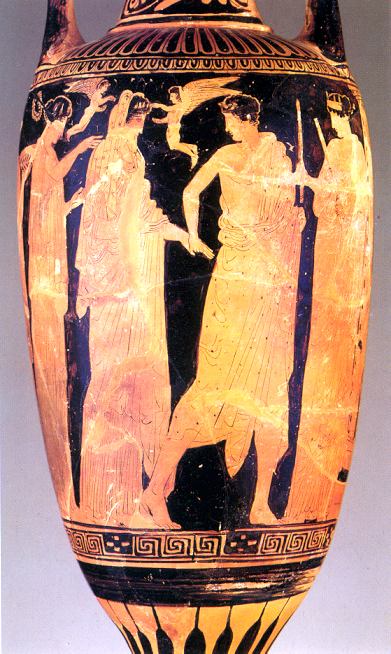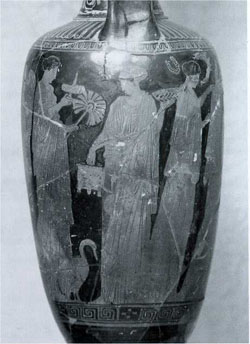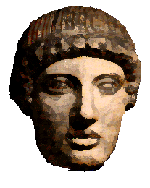Loutrophoros
The Athenian marriage vase

This loutrophoros tells us nearly all we need to know about marriage in 5th century Athens.
Marriage was the transfer of a girl from one master (kyrios) - her father, to another - her man. There were no specific words in Greek for husband and wife - aner, man is the only word, and gyne, woman, assumes that woman=wife. Being unmarried could never be a choice - only a misfortune, and would bring shame to the girl's father if she were too ugly, or he not rich enough to afford a decent dowry for her. Medea equates the dowry with "buying a husband" - although the girl is unlikely to have had a say in the purchase. We see the father and the "man" shake hands to confirm that marriage is agreed ( engue - betrothal -would usually take place years earlier - the vase compresses all the events)
The vase was specially ordered by the new kyrios to bring water from the stream of Kallirhoe for the bride's bath: she was assumed to be in need of purification after her journey from her father's house. Her old life is symbolically washed away, and she is prepared for intercourse, which will change her status from parthenos (virgin) to gyne (woman).
-
 The couple do not hold hands - as often shown in Roman marriage
scenes. He symbolically captures her by clutching her limply
outstretched fingers (on most loutrophoroi he's actually grabbing her
wrist).
The couple do not hold hands - as often shown in Roman marriage
scenes. He symbolically captures her by clutching her limply
outstretched fingers (on most loutrophoroi he's actually grabbing her
wrist).
-
The man is unbearded - not normal for a man of thirty, which was the usual age for marriage in a man (the girl will of course be very much younger - marriage would follow menarche as soon as possible). But the artist wants to distinguish him from the bearded father, shown at the betrothal ceremony - when the man would probably in fact have been too young for a beard.
-
Her eyes are suitably downcast - and her head is veiled (though not her face - perhaps she has just uncovered herself, which is why the groom is looking back at her as he strides purposefully towards the bedroom!).
-
She is beautifully dressed (showing her father's wealth) - note the pattern on her transparent mantle, and the diadem.
-
She has an attendant to help her with her mantle (wealth again).
-
It is night-time (the woman on the right carries torches).
-
The two little Erotes (cupids) above her head denote the sexual thoughts that the male painter and owner of the vase assume she is having. One carries a necklace - to make her more desirable (also shows her father's wealth!), and the other a wreath - a symbol of victory (hers or his?)
-
 It's unclear in this painting whether she's holding anything in her
right hand - in other loutrophoroi it's often a small roundish object,
variously supposed to be an egg or a pomegranate. Either would symbolise
the purpose of the marriage - to produce sons who will enable the family
(oikos) of the kyrios to continue.
It's unclear in this painting whether she's holding anything in her
right hand - in other loutrophoroi it's often a small roundish object,
variously supposed to be an egg or a pomegranate. Either would symbolise
the purpose of the marriage - to produce sons who will enable the family
(oikos) of the kyrios to continue.
-
On the far right, you can just make out a pillar - this is the door to her new oikos, and the woman with the two torches is the man's mother - welcoming her to her confinement in a new women's quarters (gynaikonitis).
-
Round the side is part of the marriage-bed, with a sword hanging over it (obvious symbolism!) - and another Eros - a baby boy - is leaping out in excitement to meet them, reminding the bride that she's expected to produce one of her own as soon as possible.
-
On the opposite side we see the ceremony of epaulia - attendants bring gifts - bowl, perfume and a chest to keep her things in. The goose, sacred to Aphrodite, is a reminder of last night's successful sex.

